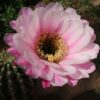
Trichocereus purpureopilosus aka Echinopsis purpureopilosa was originally described by Weingart. Friedrich et al. integrated the species in 1974 into the species Echinopsis lamprochlora. This was a highly questionable decision and I treat it as a correct species here. Joel Lodé lists it as a correct species in his book TAXONOMY OF THE CACTACEAE and I fully agree.
The plant on this pictures is what was known as Trichocereus purpureopilosus. It is a very attractive plant and was used extensively in hybrid culture. The flower is purple and looks amazing. The modern taxonomy placed this plant in the messed up species Trichocereus lamprochlorus and though I dont really agree with it being synonymous with lamprochlorus, I will definitely add this piece of information on this page.
Origin: Argentina, Sierra de Cordoba
This type of Trichocereus is pupping from the base and can grow upwards or laying sideways/creeping. It can reach a size of up to 60 centimeters and has a maximum diameter of 7 centimeters. The color of the epidermis is a very dark, wet green and has a shiny texture. It can reach up to 12 ribs and has 18-22 very thin radial spines that are up to 8 mm long. Besides, it has up to 5 middle spines that are yellow in color and have a slightly swollen base.
Flower of Trichocereus purpureopilosus:
The flower is white with a pink undertone. More than 20 centimeters large with an ovary that is up to 2,5 centimeters long. The sepals are up to 5 centimeters long and have a dark red color. The petals are double-rowed, up to 5 centimeters long and between 1-2 centimeters wide. The stamens are yellow-green. Please note that there are many hybrids around that have all kinds of flower colors.
This species is used for Hildewintera hybrids (now Cleistocactus), Trichocereus candicans hybrids and some more Echinopsis hybrids.
Synonyms: Trichocereus spachianus “Hungaricus”, Trichocereus spachianus (only some forms), Trichocereus Imperalis (which is a hybrid between Trichocereus and Echinopsis involving Trichocereus purpureopilosus, created by a well known breeder called Fonteyne)
Please note that those plants are extremely common on the commercial market, especially among hybrid breeders. And every hybrid can be different.
As a comparison, here is a pic of Trichocereus brevispiulosus on Trouts website. They are definitely close, but they are probably closer to Trichocereus thelegonus than to T. purpureopilosus. I consider them to be a Trichocereus thelegonus x Trichocereus purpureopilosus hybrid or something like that, but that´s just speculation.
(It is obvious that it involves Trichocereus purpureopilosus though. Either as a father, or a mother, which was already indicated by the earlier version of this article. I am editing it again because someone must´ve overlooked when I wrote that “I CONSIDER THEM TO BE A TRICHOCEREUS THELEGONUS x PURPUREOPILOSUS HYBRID”, so I need to underline that again. )
You can see the typical Thelegonus-like edging, but without it´s typical spines. I will also include this plant on the page about Trichocereus thelegonus because it seems to be very closely related to it. The flower is also very typical to Thelegonus and it´s probably a thelegonus hybrid. However, there are many Purpureopilosus hybrids that have a much more distinct thelegonus-like edging than the one in the first two Purpureopilosus pics on this page and I will add some more to show how variable that whole group is. That variability is probably caused by hybrid culture though:

Check out our main plant database pages for Trichocereus pachanoi aka Echinopsis pachanoi here:
And Trichocereus bridgesii here:
Trichocereus scopulicola
Also check out our Trichocereus Facebook group here:









